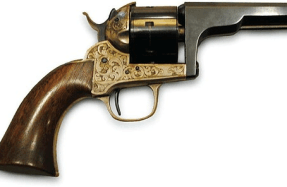CLOAKED VENGEANCE


On a raw mid-February day in 1864, two brigades of Confederate soldiers stood at attention around a makeshift gallows. They had been formed up to witness the deaths of 13 Union prisoners. Following the reading of the execution order, a signal was given and the platform upon which the bound and hooded Yankees stood dropped away. The deed sent shockwaves across the North and sections of the South, as well as calls for a reckoning against the hangings’ perpetrator that outlasted the war itself. This, however, was not the first execution of Union prisoners to be ordered that month by Confederate Maj. Gen. George E. Pickett. Nor would it be the last.
Throughout the war, the charming, foppishly vain Virginia aristocrat, who had famously finished last among an elite class of 59 cadets at the U.S. Military Academy in 1846, had been neither the brightest nor the most inspired of the South’s generals. Typically, Pickett’s inflated self-opinion had far outstripped reality; however, since the doomed July 3, 1863, charge at Gettysburg for which he is best remembered——the Confederates’ bloody frontal assault on Cemetery Ridge known as Pickett’s Charge—the general was clearly a changed man.
The order for that decisive Gettysburg assault had come not from Pickett but from the storied commander of the Army of Northern Virginia, General Robert E. Lee. Nevertheless, Pickett watched in helpless frustration, tears coursing down his cheeks, as nearly 9,000 troops from his own and two other Confederate divisions fell before the Yankee guns or were rounded up as POWs, marking the bitter conclusion to Lee’s second Northern invasion and presaging the South’s eventual defeat in 1865. It was a disconsolate, vengeful Pickett who retired from the field that day, replying with acrimony to Lee’s post-charge order to “rally” his division in case of a Union counterattack: “General, I have no division!”
After Gettysburg, Pickett was given command of the Department of North Carolina. It proved an impossible assignment. North Carolina had been a problem state for the Confederacy from the opening of hostilities. Unlike its sister state to the immediate south, which, “Whatever sectional discord existed between Northern and Southern states could in no discernible way relate to their own base and secluded existence. If they recognized any responsibility, it was to use whatever common sense they possessed to find ways to avoid being taken away from their bare board, ramshackle homes and near-worthless acres….”
You’re reading a preview, subscribe to read more.
Start your free 30 days





